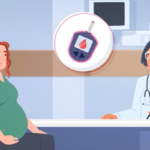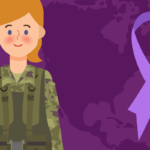Every year, roughly 500,000 people in the United States undergo a hysterectomy. This makes it the second most common surgery for people with uteruses behind cesarean sections. In 2018, nearly one-third of American women* aged 50 and older had had a hysterectomy, according to the U.S. Centers for Disease Control and Prevention (CDC).
Though hysterectomy rates are going down overall, Black women remain more likely to undergo the procedure than any other group, according to the CDC. In fact, one 2009 study found that Black women were three times more likely than white women to have a hysterectomy, and some experts put that number even higher.
What is a hysterectomy?
A hysterectomy is a surgical procedure to remove the uterus; after it is performed, the patient is no longer able to become pregnant. Other nearby organs — such as the ovaries, fallopian tubes and cervix — may also be removed. If both ovaries are removed, menopause immediately occurs.
Because a hysterectomy is permanent and can’t be reversed, in most cases, it’s the treatment of last resort.
“We have much better therapies and there have been a lot of advances in medical interventions that can usually be tried before surgery,” said Dr. Mary Jane Minkin, a clinical professor in the Department of Obstetrics, Gynecology and Reproductive Science at the Yale School of Medicine and a member of HealthyWomen’s Women’s Health Advisory Council.
Reasons for a hysterectomy
The most common reason for a hysterectomy is uterine fibroids.
Black women are more likely than other ethnicities to have fibroids. More research is needed to understand why, but this may be one reason they are far more likely to undergo a hysterectomy than white women.
Other reasons for hysterectomy include:
- Gynecologic cancer (involving cancer of the cervix, ovaries, uterus and vagina)
- Chronic pelvic pain
- Pelvic support concerns, such as uterine prolapse
- Endometriosis
- Abnormal uterine bleeding
For most conditions, there’s no rush to surgery because other treatments can be tried first. However, Minkin said that with serious conditions, such as severe uterine bleeding or gynecologic cancer, there may not be time to try alternative treatments; a hysterectomy could be life-saving.
Types of hysterectomy
- Partial or supracervical hysterectomy: Only the uterus is removed.
- Total hysterectomy: The uterus and the cervix are both removed.
- Total hysterectomy with unilateral or bilateral salpingo-oophorectomy: In addition to the uterus and cervix, one (unilateral) or both (bilateral) ovaries and fallopian tubes are removed.
- Radical hysterectomy: The cervix, uterus, part of the vagina and tissues around the uterus may be removed, as well lymph nodes that parallel the uterus.
It’s important to know there could be a change in procedure during surgery, and the surgeon might need to remove more organs than originally planned.
“There are times when we find something unexpected when we start surgery, and we may have to convert to a procedure that’s more complex,” Minkin said.
How surgery is performed
Vaginal hysterectomy is performed through a small incision in the vagina. “If you can get a uterus out vaginally, that’s ideal. The recuperation tends to be quicker,” Minkin said.
Laparoscopic hysterectomy uses small incisions in the abdominal wall, easy-to-maneuver surgical tools and a long, thin, lighted instrument called a laparoscope to allow the surgeon to see inside the body. Laparoscopic surgery may also be done with the assistance of a robotic laparoscope controlled by a surgeon.
Abdominal hysterectomy is done via larger incisions than for the laparoscope, in the lower abdomen. This procedure is associated with a greater risk for complications and longer recovery, according to the American College of Obstetricians and Gynecologists. “If there are a lot of adhesions (scar tissue) or you have a large mass, we may need to go the open abdominal route,” Minkin said.
Hysterectomy risks
“There are risks associated with general anesthesia, [and] a risk of injuring the bladder, the ureter or the intestines,” said Dr. Adina Keller, associate chief of obstetrics and gynecology at Northern Westchester Hospital.
If you haven’t gone through menopause previously and your ovaries are removed with your uterus, you’ll immediately go into menopause. Your doctor may prescribe hormone replacement therapy to lessen the symptoms and to help reduce your risk for osteoporosis.
Post-surgery
Recovery time after surgery varies, but Minkin tells her patients to plan on about six weeks of down time.
“No one ever believes me, but after a week or two, you get hit with extreme fatigue,” Minkin said. “You’ll think you’re fine to go back to work, but around two weeks, you’re going to need a nap to get through the day. Surgery is an insult to the body, and you get very fatigued during recovery.”
Hysterectomy can also take an emotional toll. “Some women mourn the loss of their ability to procreate,” Keller explained.
Some may also experience depression after their hysterectomy, while others may feel relief because their troubling symptoms disappear.
“Before hysterectomy, it’s important for women to speak with their doctor about all the other options and why hysterectomy is appropriate for them,” Keller said.
Hysterectomy alternatives
Depending on your condition, there may be a number of treatment options you can try before a hysterectomy.
“Fibroids are hormone-dependent. After menopause, estrogen goes down and you’re no longer feeding the fibroid,” Minkin explained. “If you can wait it out, they can totally disappear after menopause. But if you’re young — 30s or 40s — you may not be able to wait it out comfortably.”
Endometriosis and heavy menstrual bleeding can also be treated with alternatives. “If a woman has heavy bleeding, low-dose birth control pills, an IUD or an ablation procedure that destroys the lining of the uterus are options,” Keller said.
Women with pelvic floor issues may use pelvic exercises or devices called vaginal pessaries as alternative treatments to hysterectomy.
“If there are other things that can be done, try those first,” Minkin said. “The decision is ultimately yours, and you usually have time to make the decision or to get a second opinion.”
*As classified by the CDC.















